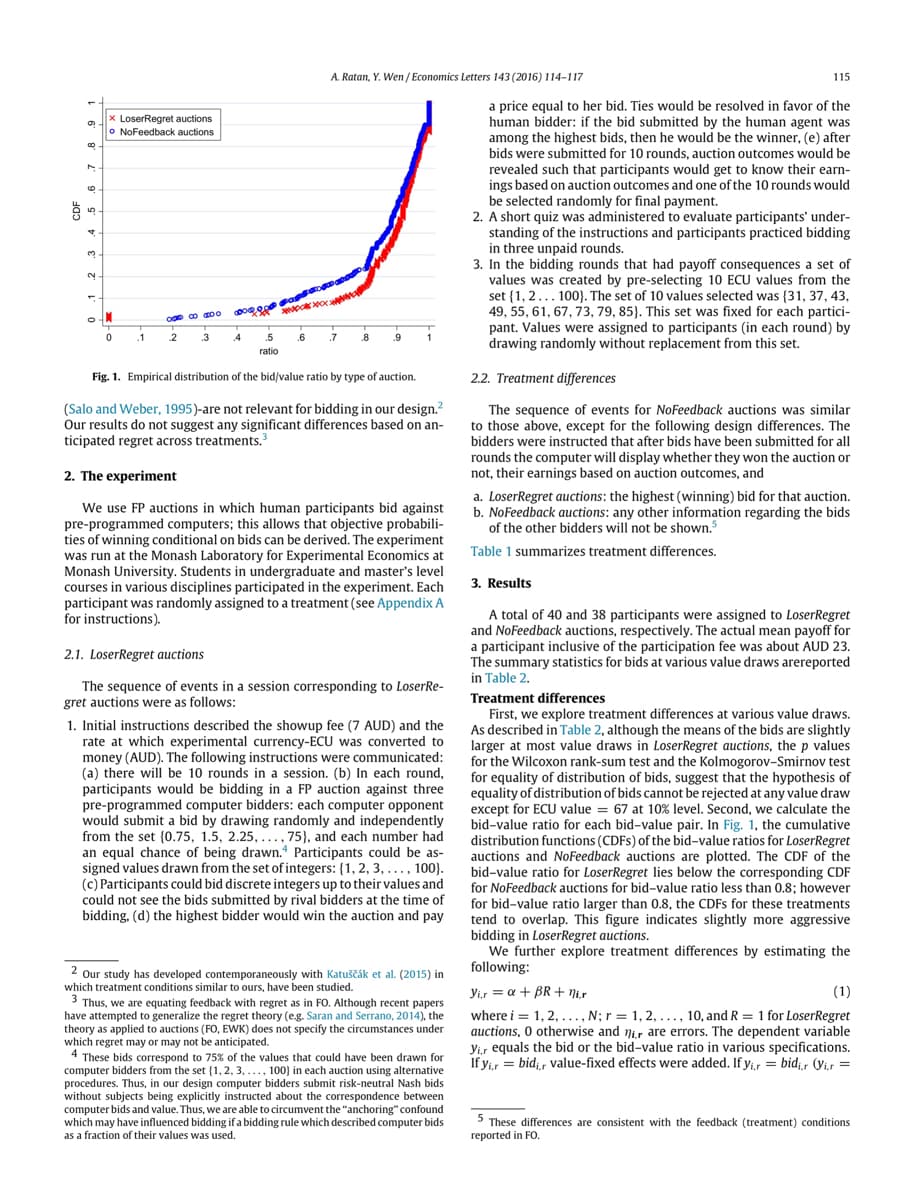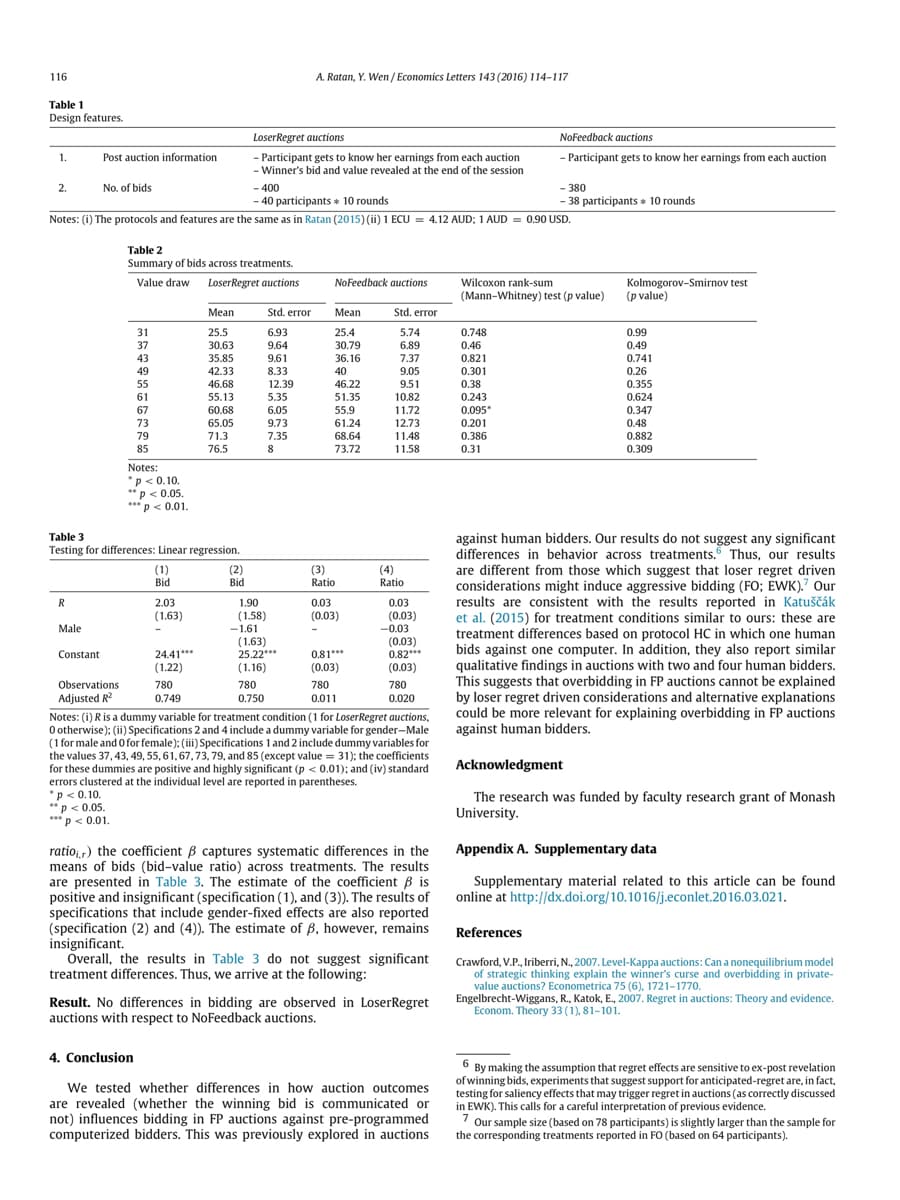Chapter1: Making Economics Decisions
Section: Chapter Questions
Problem 1QTC
Related questions
Question
Explain with clear brief points with correct answer - please do not attempt to answer if you are not confident please do not waste my chance to ask questions as they are not for free and please do not copy.
What methodology do the authors use and why? Are there any implications of the finding for policy makers or business leaders?

Transcribed Image Text:វ៉
Co
(0
5
3
2
O
x LoserRegret auctions
o NoFeedback auctions
IM
0
.1
000
2
BO
3
4
.5
ratio
.6
A. Ratan, Y. Wen/Economics Letters 143 (2016) 114-117
.7
8 .9
1
Fig. 1. Empirical distribution of the bid/value ratio by type of auction.
(Salo and Weber, 1995)-are not relevant for bidding in our design.²
Our results do not suggest any significant differences based on an-
ticipated regret across treatments.³
2. The experiment
We use FP auctions in which human participants bid against
pre-programmed computers; this allows that objective probabili-
ties of winning conditional on bids can be derived. The experiment
was run at the Monash Laboratory for Experimental Economics at
Monash University. Students in undergraduate and master's level
courses in various disciplines participated in the experiment. Each
participant was randomly assigned to a treatment (see Appendix A
for instructions).
2.1. LoserRegret auctions
The sequence of events in a session corresponding to LoserRe-
gret auctions were as follows:
1. Initial instructions described the showup fee (7 AUD) and the
rate at which experimental currency-ECU was converted to
money (AUD). The following instructions were communicated:
(a) there will be 10 rounds in a session. (b) In each round,
participants would be bidding in a FP auction against three
pre-programmed computer bidders: each computer opponent
would submit a bid by drawing randomly and independently
from the set (0.75, 1.5, 2.25,...,75), and each number had
an equal chance of being drawn. Participants could be as-
signed values drawn from the set of integers: {1, 2, 3, ..., 100).
(c) Participants could bid discrete integers up to their values and
could not see the bids submitted by rival bidders at the time of
bidding, (d) the highest bidder would win the auction and pay
2 Our study has developed contemporaneously with Katuščák et al. (2015) in
which treatment conditions similar to ours, have been studied.
3 Thus, we are equating feedback with regret as in FO. Although recent papers
have attempted to generalize the regret theory (e.g. Saran and Serrano, 2014), the
theory as applied to auctions (FO, EWK) does not specify the circumstances under
which regret may or may not be anticipated.
4 These bids correspond to 75% of the values that could have been drawn for
computer bidders from the set (1, 2, 3, ..., 100) in each auction using alternative
procedures. Thus, in our design computer bidders submit risk-neutral Nash bids
without subjects being explicitly instructed about the correspondence between
computer bids and value. Thus, we are able to circumvent the "anchoring" confound
which may have influenced bidding if a bidding rule which described computer bids
as a fraction of their values was used.
115
a price equal to her bid. Ties would be resolved in favor of the
human bidder: if the bid submitted by the human agent was
among the highest bids, then he would be the winner, (e) after
bids were submitted for 10 rounds, auction outcomes would be
revealed such that participants would get to know their earn-
ings based on auction outcomes and one of the 10 rounds would
be selected randomly for final payment.
2. A short quiz was administered to evaluate participants' under-
standing of the instructions and participants practiced bidding
in three unpaid rounds.
3. In the bidding rounds that had payoff consequences a set of
values was created by pre-selecting 10 ECU values from the
set (1, 2... 100). The set of 10 values selected was (31, 37, 43,
49, 55, 61, 67, 73, 79, 85). This set was fixed for each partici-
pant. Values were assigned to participants (in each round) by
drawing randomly without replacement from this set.
2.2. Treatment differences
The sequence of events for NoFeedback auctions was similar
to those above, except for the following design differences. The
bidders were instructed that after bids have been submitted for all
rounds the computer will display whether they won the auction or
not, their earnings based on auction outcomes, and
a. LoserRegret auctions: the highest (winning) bid for that auction.
b. NoFeedback auctions: any other information regarding the bids
of the other bidders will not be shown.5
Table 1 summarizes treatment differences.
3. Results
A total of 40 and 38 participants were assigned to LoserRegret
and NoFeedback auctions, respectively. The actual mean payoff for
a participant inclusive of the participation fee was about AUD 23.
The summary statistics for bids at various value draws arereported
in Table 2.
Treatment differences
First, we explore treatment differences at various value draws.
As described in Table 2, although the means of the bids are slightly
larger at most value draws in LoserRegret auctions, the p values
for the Wilcoxon rank-sum test and the Kolmogorov-Smirnov test
for equality of distribution of bids, suggest that the hypothesis of
equality of distribution of bids cannot be rejected at any value draw
except for ECU value = 67 at 10% level. Second, we calculate the
bid-value ratio for each bid-value pair. In Fig. 1, the cumulative
distribution functions (CDFs) of the bid-value ratios for LoserRegret
the vide
Co
auctions and NoFeedback auctions are plotted. The CDF of the
bid-value ratio for LoserRegret lies below the corresponding CDF
for NoFeedback auctions for bid-value ratio less than 0.8; however
for bid-value ratio larger than 0.8, the CDFs for these treatments
tend to overlap. This figure indicates slightly more aggressive
bidding in LoserRegret auctions.
We further explore treatment differences by estimating the
following:
yir = a + BR+ ni.r
(1)
where i = 1, 2, ..., N; r = 1, 2,..., 10, and R = 1 for LoserRegret
auctions, 0 otherwise and nir are errors. The dependent variable
yir equals the bid or the bid-value ratio in various specifications.
If yir = bidi,r value-fixed effects were added. If yir= bidir (Vi.r =
5 These differences are consistent with the feedback (treatment) conditions
reported in FO.

Transcribed Image Text:116
Table 1
Design features.
Loser Regret auctions
Participant gets to know her earnings from each auction
Winner's bid and value revealed at the end of the session
- 400
40 participants 10 rounds
Notes: (i) The protocols and features are the same as in Ratan (2015) (ii) 1 ECU = 4.12 AUD; 1 AUD = 0.90 USD.
1.
2.
R
Post auction information
Male
Constant
No. of bids
Table 2
Summary of bids across treatments.
Value draw LoserRegret auctions
** p < 0.05.
*** p <0.01.
31
37
43
49
55
Table 3
Testing for differences: Linear regression.
61
67
73
79
85
Notes:
*p<0.10.
**p<0.05.
*** p<0.01.
(1)
Bid
4. Conclusion
2.03
(1.63)
Mean
25.5
30.63
35.85
42.33
46.68
55.13
60.68
65.05
71.3
76.5
24.41***
(1.22)
780
0.749
(2)
Bid
1.90
(1.58)
-1.61
Std. error
6.93
9.64
9.61
8.33
12.39
5.35
6.05
9.73
7.35
8
(1.63)
25.22***
(1.16)
780
0.750
A. Ratan, Y. Wen/Economics Letters 143 (2016) 114-117
NoFeedback auctions
Mean
25.4
30.79
36.16
40
46.22
51.35
55.9
61.24
68.64
73.72
(3)
Ratio
0.03
(0.03)
0.81***
(0.03)
780
0.011
Std. error
5.74
6.89
7.37
9.05
9.51
10.82
11.72
12.73
11.48
11.58
(4)
Ratio
Observations
Adjusted R2
Notes: (i) R is a dummy variable for treatment condition (1 for LoserRegret auctions,
0 otherwise); (ii) Specifications 2 and 4 include a dummy variable for gender-Male
(1 for male and 0 for female); (iii) Specifications 1 and 2 include dummy variables for
the values 37, 43, 49, 55, 61, 67, 73, 79, and 85 (except value = 31); the coefficients
for these dummies are positive and highly significant (p < 0.01); and (iv) standard
errors clustered at the individual level are reported in parentheses.
*p <0.10.
0.03
(0.03)
-0.03
(0.03)
0.82***
(0.03)
780
0.020
ratior) the coefficient ß captures systematic differences in the
means of bids (bid-value ratio) across treatments. The results
are presented in Table 3. The estimate of the coefficient is
positive and insignificant (specification (1), and (3)). The results of
specifications that include gender-fixed effects are also reported
(specification (2) and (4)). The estimate of B, however, remains
insignificant.
Overall, the results in Table 3 do not suggest significant
treatment differences. Thus, we arrive at the following:
Result. No differences in bidding are observed in LoserRegret
auctions with respect to NoFeedback auctions.
We tested whether differences in how auction outcomes
are revealed (whether the winning bid is communicated or
not) influences bidding in FP auctions against pre-programmed
computerized bidders. This was previously explored in auctions
0.748
0.46
0.821
0.301
0.38
Wilcoxon rank-sum
(Mann-Whitney) test (p value)
0.243
0.095*
NoFeedback auctions
- Participant gets to know her earnings from each auction
0.201
0.386
0.31
-380
38 participants 10 rounds
Kolmogorov-Smirnov test
(p value)
0.99
0.49
0.741
0.26
0.355
0.624
0.347
0.48
0.882
0.309
against human bidders. Our results do not suggest any significant
differences in behavior across treatments. Thus, our results.
are different from those which suggest that loser regret driven
considerations might induce aggressive bidding (FO; EWK). Our
results are consistent with the results reported in Katuščák
CL
et al. (2015) for treatment conditions similar to ours: these are
CHC
treatment differences based on protocol HC in which one human
bids against one computer. In addition, they also report similar
qualitative findings in auctions with two and four human bidders.
This suggests that overbidding in FP auctions cannot be explained
by loser regret driven considerations and alternative explanations
could be more relevant for explaining overbidding in FP auctions
against human bidders.
Acknowledgment
The research was funded by faculty research grant of Monash
University.
Appendix A. Supplementary data
Supplementary material related to this article can be found.
online at http://dx.doi.org/10.1016/j.econlet.2016.03.021.
References
Crawford, V.P., Iriberri, N., 2007. Level-Kappa auctions: Can a nonequilibrium model
of strategic thinking explain the winner's curse and overbidding in private-
value auctions? Econometrica 75 (6), 1721-1770.
Engelbrecht-Wiggans, R., Katok, E., 2007. Regret in auctions: Theory and evidence.
Econom. Theory 33 (1), 81-101.
6 By making the assumption that regret effects are sensitive to ex-post revelation
of winning bids, experiments that suggest support for anticipated-regret are, in fact,
testing for saliency effects that may trigger regret in auctions (as correctly discussed
in EWK). This calls for a careful interpretation of previous evidence.
7 Our sample size (based on 78 participants) is slightly larger than the sample for
the corresponding treatments reported in FO (based on 64 participants).
Expert Solution
This question has been solved!
Explore an expertly crafted, step-by-step solution for a thorough understanding of key concepts.
Step by step
Solved in 4 steps

Knowledge Booster
Learn more about
Need a deep-dive on the concept behind this application? Look no further. Learn more about this topic, economics and related others by exploring similar questions and additional content below.Recommended textbooks for you


Principles of Economics (12th Edition)
Economics
ISBN:
9780134078779
Author:
Karl E. Case, Ray C. Fair, Sharon E. Oster
Publisher:
PEARSON

Engineering Economy (17th Edition)
Economics
ISBN:
9780134870069
Author:
William G. Sullivan, Elin M. Wicks, C. Patrick Koelling
Publisher:
PEARSON


Principles of Economics (12th Edition)
Economics
ISBN:
9780134078779
Author:
Karl E. Case, Ray C. Fair, Sharon E. Oster
Publisher:
PEARSON

Engineering Economy (17th Edition)
Economics
ISBN:
9780134870069
Author:
William G. Sullivan, Elin M. Wicks, C. Patrick Koelling
Publisher:
PEARSON

Principles of Economics (MindTap Course List)
Economics
ISBN:
9781305585126
Author:
N. Gregory Mankiw
Publisher:
Cengage Learning

Managerial Economics: A Problem Solving Approach
Economics
ISBN:
9781337106665
Author:
Luke M. Froeb, Brian T. McCann, Michael R. Ward, Mike Shor
Publisher:
Cengage Learning

Managerial Economics & Business Strategy (Mcgraw-…
Economics
ISBN:
9781259290619
Author:
Michael Baye, Jeff Prince
Publisher:
McGraw-Hill Education